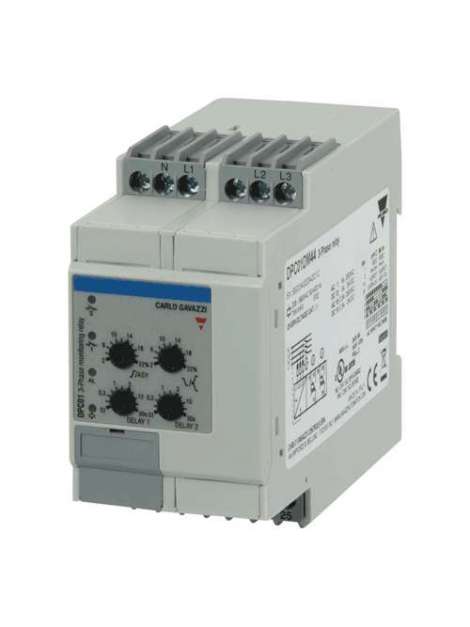



DPC01DM44, Three-phase voltage control relay, TRMS measurement, DPC01DM44, DPC01DM44 relay is a three-phase multifunction electrical network monitoring device. It can operate in three-phase and three-phase + neutral networks where they detect, in addition to phase losses and the correct phase sequence, possible overvoltages and subtensions or excess asymmetry and tolerance. They are powered through the monitored network with a wide input range, thanks to the internal switched power supply. Consumption, dissipation and, consequently, heat are very low. Certified for marine applications. Works with three-phase networks up to 400 Hz., DPC01DM44, Suitability: The DPC01DM44 relay is suitable for network quality control and three-phase load lines, with or without neutral, with rated supply voltage of 208 WL at 690 WL and frequencies from 50 to 400Hz. It can be configured to monitor undervoltage/surge or voltage asymmetry/tolerance between phases. Device configuration: The relay works when all phases are present, the sequence of these is correct and the phase-phase voltage levels are within the established limits. The delay to the connection can be adjusted with the front potentiometers. Each of the alarms (undervoltage/overvoltage or asymmetry/tolerance) can be adjusted with independent delays. Alarms: The output relays are immediately disconnected (<200 ms) in case of phase loss or incorrect phase sequence. In addition, they are also disconnected after the delay to the connection adjusted for the detection of events: Overvoltage Subtension Asymmetry Network voltage out of tolerance The detection of overvoltage or asymmetry involves the deactivation of relay 1 and LED 1, when the delay to the adjusted connection of alarm 1 has been met. The "AL" LED flashes red in slow mode over the course of the delay and lights up fixed at the end of the delay. The detection of undervoltage or out of tolerance involves the deactivation of relay 2 and LED 2, when the delay to the adjusted connection of alarm 2 has been met. The "AL" LED flashes red in slow mode over the course of the delay and lights up fixed at the end of the delay. Visual information: DPC01DM44 have 4 front LEDs that provide information on the operating status. The yellow LED 1 lights up when the output relay 1 is activated. The yellow LED 2 lights up when the output relay 2 is activated. The "AL" LED provides information about the alarm status: when an overvoltage/undervoltage or tolerance/asymmetry activation occurs but an alarm delay is elapsed, the LED flashes red at 2Hz during the delay and, once the delay has elapsed, if the alarm condition is still present, it glows fixed. If a phase is lost, the phase sequence is incorrect and the LED flashes in fast mode at 5 Hz. The green LED lights up if at least two phases are supplied. Phase loss: Phase loss measurement is performed by comparing the 3 phase voltages (L1-L2, L2-L3, L3-L1) or phase to neutral (L1-N, L2-N, L3-N) in the 3F + N network type. If the voltage of one phase falls below 70% compared to the other 2 phases, the alarm goes off. The DPC01DM44 relay detects voltage regenerated by loads, for example in the case of motor or transformer loads. Asymmetry: Asymmetry is an indicator of the quality of the network and is defined as the absolute value of the maximum deviation between the voltages of the network, divided by the nominal voltage of the three-phase system. The definition changes according to the voltage reference: 1) If phase-phase voltages are measured: (max |∆VLL|/VNOM) *100 2) If phase-neutral voltages are measured: (max |∆VLN|/VNOM) *100 Tolerance: Tolerance is another indication of the quality of the network and is defined as the absolute value of the maximum deviation of the mains voltages from the nominal voltage, divided by the nominal voltage of the three-phase system. The definition changes according to the voltage reference: 1) If phase-phase voltages are measured: (max | V∆NOM VLL| / V∆NOM )*100 2) If phase-neutral voltages are measured: (max | VNOM VLN| / VNOM ) * 100
No customer reviews for the moment.
Or Insert your account information: